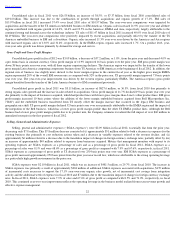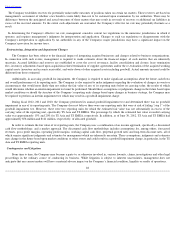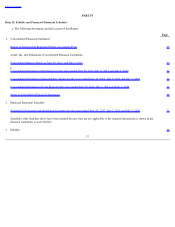Avnet 2012 Annual Report Download - page 30
Download and view the complete annual report
Please find page 30 of the 2012 Avnet annual report below. You can navigate through the pages in the report by either clicking on the pages listed below, or by using the keyword search tool below to find specific information within the annual report.
Table of Contents
Revenue Recognition
The Company does not consider revenue recognition to be a critical accounting policy due to the nature of its business because revenues
are generally recognized when persuasive evidence of an arrangement exists, delivery has occurred or services have been rendered, the sales
price is fixed or determinable and collectability is reasonably assured. Generally, these criteria are met upon the actual shipment of product to the
customer. Accordingly, other than for estimates related to possible returns of products from customers, discounts or rebates, the recording of
revenue does not require significant judgments or estimates.
Provisions for returns are estimated based on historical sales returns, credit memo analysis and other known factors. Provisions are made for
discounts and rebates, which are primarily volume-
based, and are generally based on historical trends and anticipated customer buying patterns.
Finally, revenues from maintenance contracts, which are deferred and recognized in income over the life of the agreement, are not material to the
consolidated results of operations of the Company.
Recently Issued Accounting Pronouncements
See Note 1 in the Notes to Consolidated Financial Statements
contained in Item 15 of this Report for the discussion of recently issued
accounting pronouncements.
Liquidity and Capital Resources
Cash Flows
Cash Flows from Operating Activities
The Company generated $528.7 million of cash from operating activities in fiscal 2012 as compared with $278.1 million in fiscal 2011.
These results are comprised of: (1) cash flow generated from net income excluding non-
cash and other reconciling items, which includes the
add-back of depreciation and amortization, deferred income taxes, stock-based compensation and other non-
cash items (primarily the provision
for doubtful accounts and periodic pension costs) and (2) cash flow used for working capital, excluding cash and cash equivalents. Cash
generated by working capital in fiscal 2012 resulted from a decrease in receivables and inventory of $72.3 million and $133.2 million,
respectively, offset by a decrease in payables of $319.1 million and in accrued expenses and other of $136.9 million. EM drove the decrease in
receivables and inventory which more than offset the increase in receivables at TS. TS inventory was essentially flat year over year. Net days
outstanding, in particular, receivable days, has not changed significantly as there has not been any significant change in terms provided to
customers nor are customers changing their payment patterns.
During fiscal 2011, the Company generated $278.1 million of cash from operating activities as compared with cash used for operating
activities of $30.4 million in fiscal 2010. Cash used for working capital in fiscal 2011 consisted of growth in accounts receivable and inventory
of $421.5 million and $321.9 million, respectively, partially offset by an increase in payables of $165.2 million. Cash used for working capital
during fiscal 2010 consisted of growth in accounts receivable and inventory of $1.07 billion and $459.9 million, respectively, partially offset by
an increase in accounts payable of $963.3 million. For fiscal 2010, sales increased 18.1%; however, the Company used only $30.4 million of
cash from operating activities to fund that growth as a result of the significant improvement in working capital velocity which increased to a
record 7.8 times.
Cash Flows from Financing Activities
During fiscal 2012, the Company received net proceeds of $595.8 million, primarily from borrowings under the accounts receivable
securitization program and bank credit facilities. In addition, during fiscal 2012, the Company used $318.3 million of cash to repurchase
common stock under the $500 million share repurchase program authorized by the Board in August 2011 (see Item 5 .
Market for Registrants'
Common Equity, Related Stockholder Matters and Issuer Purchases of Equity Securities in this Form 10-K).
During fiscal 2011, the Company received proceeds of $160.0 million from borrowings under the accounts receivable securitization
program and repaid $109.6 million for the 3.75% Notes acquired in the Bell acquisition which were tendered during fiscal 2011. The Company
also received proceeds of $8.9 million, net of repayments, related to bank credit facilities and other debt.
During fiscal 2010, the Company received proceeds of $291.9 million from the issuance of notes, net of repayments for bank and other
debt. In June 2010, the Company issued $300.0 million 5.875% Notes due June 2020 and received proceeds of $296.5 million, net of discount
and underwriting fees.
29
























